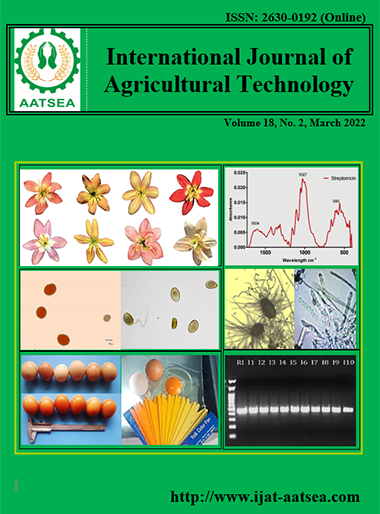Study on farmer’s economic status and acceptability of goat farm management technology: A case study in the lower central region and the upper southern region of Thailand
Main Article Content
Abstract
The results showed that the most farmers were male (67.12%), age between 31 to 40 years old (72.03 %) and 51.81% had high school education status, and 57.63 %of farmers had an experience of about 5 to 10 years in raising goat. Most of the farmers had an average 76 goats/family; 89.37% of them raised semi-caged goat. About 63.45 % of the farmers did not receive consulting opportunity for farm management form experts.The total averaged income was 226,401 THB/year. About 86.77% of goat sales were made with dealers. The goat farm management transfer was accepted in level in terms of breed and breeding management (3.68); good level on farm management, feeding, housing, and sanitation (2.98, 3.25, 3.07, and 2.51), and medium level for marketing (2.46). In the SWOT analysis of goat farming, it was found that the sheep farming career was consistent with the way of life as well as religion and traditions of the Muslim community in the selected area as strengths; marketing problems due to lack of slaughterhouses, no clear market system, and only few marketing resources available were the weaknesses; creation of policy by the government agencies to develop a network of sheep and goat farmers as an opportunity; and lastly, smuggling from neighboring countries making the goat products vulnerable to disease control was an obstacle
Article Details

This work is licensed under a Creative Commons Attribution-NonCommercial-NoDerivatives 4.0 International License.
References
Bureau of Development and Certification of Livestock Products Standards (n.d.). Manual of meat hygiene project. Department of Livestock Development, Ministry of Agriculture and Cooperatives, Bangkok.
Matthing, P. and Thungwa, S. (2013). Types and agricultural structure of goat-raising households in Tha Phae Sub-district, Tha Phae District, Satun Province. The 23rd Thaksin University Academic Conference, 1564-1667.
Mundre, S. (2020). economic enhancement of the rural community of Pusa Block through goat rearing. International Journal of Animal Health and Livestock Production Research, 4:1-40.
Nahed Toral, J., López Tecpoyotl, Z. G., Aguilar Jiménez, J. R., Grande Cano, D. and Delgadillo Puga, C. (2021). Compliance of Goat Farming under Extensive Grazing with the Organic Standards and Its Contribution to Sustainability in Puebla, Mexico. Sustainability, 13:6293.
NRC (2007). Nutrient Requirements of Small Ruminants, Sheep, Goats, Cervids and New World Camelids. The National Academies Press, Washington, D. C. 362 p.
Pangkham, P. (2012). Nutrition of small ruminant animals. Animal production technology school of agricultural technology, Suranaree University of Technology. 275 p.
Pencheva, D. N., Petkova, N. T. R. and Denev, P. P. (2012). Determination of Inulin in Dough Products. Scientific Works of UFT, pp.339-344.
Pralomkan, W. (1995). Food and feeding of goats. Department of Zoology Faculty of Natural Resources, Prince of Songkla University, pp.255.
Pralomkarn, W., Supakorn C. and Boonsanit, D. (2011). Knowledge in Goats in Thailand. Walailak Journal of Science and Technology, 9:93-105.
Poungsuk, P. (2017). Agricultural Education. School of Industrial Education and Technology. King Mongkut’s Institute of Technology Ladkrabang. 637 p.
Raksasiri, B. V. (2010). Agricultural: Self Sufficient Economy. Faculty of Animal Science and Agricultural Technology. Silpakorn University. 74 p.
Raksasiri, B. V., Vorlaphim, T., Kotsakdee, J., Thongphae, S., Pangkham, S. and Pangkham, P. (2014). A study of economic conditions and adoption of farm management technology of goat farmers: case study of Nakhon Ratchasima Province. Animal Science, 1:277-280.
Raksasiri, B. V., Paengkoum, P., Poonsuk, K., Thitisak, P. and Paengkoum, S. (2020a). Effect of inulin in creep feed on productive performance and hematological traits of goat kids. SYLWAN journal, 164:481-492.
Raksasiri, B. V., Sae-O, P., Duangchinda, P., Nopparatanamaitree, M. and Na Chiangmai, P. (2020b). A study of economic conditions and adoption of farm management technology of farm farmers. goat: A case study of Phetchaburi provinces and Prachuap Khiri Khan provinces. Compilation of the 7th King Mongkut's Institute of Technology Ladkrabang Agriculture Conference (KMAC2020). King Mongkut's Institute of Technology Ladkrabang, 86-92.
Sajwakit, A. (2008). The code of profession (Part 2). Journal of Animal Husbandry, 18:3-6.
Solaiman, S. G. (2010). Goat science and production. WILEY-BLACKWELL. A John Wiley Sons, Inc., Publication, 425 p.
Somchun, C. (2014). Raise goat in the plantation a survival. Rubber Price Fall [Online]. Retrieved June, 25, 2015, from: http://www.thairath.co.th/content/418621 (October 2, 2020).
Taweewong, P. (2018). The complete report: guidelines for the development of goat farmer’s groups and networks in Bang Bua Thong District. Nonthaburi Province. Rattanakosin Somphot Research Fund 200 years. Sukhothai Thammathirat University. 135 p.
Thungwa, S., Matthing, P. and Tharasuk, P. (2018). Goat raising in the Muslim southern lifestyle system: a case study in Tha Phae Sub-district, Tha Phae District, Satun Province. Journal of Yala Rajabhat University, 13:400-409.


